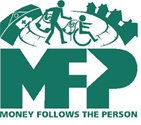Pathways to Community Living - Fact Sheet
Illinois' Money Follows the Person Demonstration
Background
The Pathways to Community Living Program is a Federal Demonstration Project authorized by the Deficit Reduction Act of 2005. The program is nationally known as the Money Follows the Person Demonstration.
The program is part of a larger effort resulting from the U.S. Supreme Court Olmstead decision in 1999. The Olmstead decision required states to take action to ensure that individuals with disabilities in need of long term care had access to services in the least restrictive and most integrated setting.
The program seeks to increase the use of community services and rebalance the state's long term care systems by providing appropriate, person-centered services for individuals interested in transitioning from nursing facilities to qualified home and community based settings.
In Illinois, the program is overseen by the Department of Healthcare and Family Services, in partnership with the Department of Human Services, the Department on Aging, and the Illinois Housing Development Authority.
Program Components and Benefits
Transition coordinators work with each individual to determine eligibility and ability to live in the community, and follow up for 365 days after transition as an added community support.
Assistance is provided in locating eligible housing that is affordable and accessible and with the actual move, including moving costs.
An individual care plan is developed with consumers to determine necessary services and supports to meet each individual's needs. This also helps consumers to safely live in a community setting.
Consumer Eligibility Requirements
Targeted Population – Illinois has chosen to target four populations of individuals - individuals over age 60, individuals with physical disabilities, individuals with serious mental illness, or individuals with intellectual/developmental disabilities who live in a nursing home or long term care facility.
Eligibility – Currently reside in a nursing facility or Intermediate Care Facility for the Developmentally Disabled for at least 90 days, currently be receiving Medicaid or be eligible for it, able to be safely supported in the community, and move to a qualified housing setting.
Must be Interested in Moving to Qualified Community Housing – Housing includes a home owned or leased by the individual or family, an apartment with individual lease, a community setting with no more than four unrelated individuals, or a Supportive Living Program facility may be a housing option for individuals age 65 and older.
Who Can Make a Referral?
Anyone can make a referral, which will lead to an assessment and eligibility determination for the program.
Pathways to Community Living Partner Agencies:
For more information, including how to make a referral, please visit us on the web at:
HFS 9 (N-4-12)
IOCI0400-12






